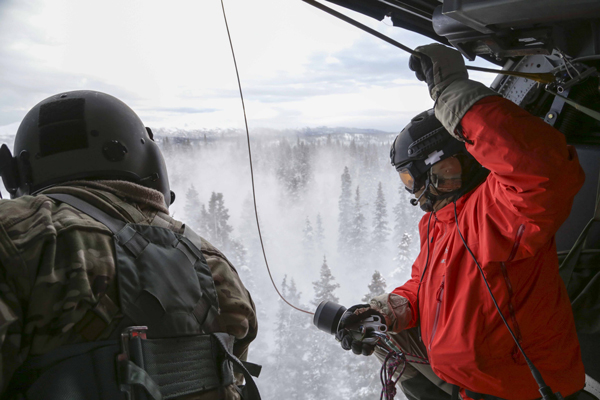
In 2014, Alaska’s Air National Guard rescued more than 90 people. They picked up individuals from downed aircrafts, snow machines that fell through ice, and lost hikers in the wilderness.
The 49-person search and rescue squadrons are credited with saving over 2,000 lives in Alaska over the past 20 years. But they also deploy abroad providing rescue capabilities for the Air Force in Afghanistan, Iraq and even Djibouti in East Africa. Many of their skills are honed during training missions around the state. They let KSKA’s Anne Hillman tag along on one late last month.
My flight aboard a HH-60 Pave Hawk helicopter starts like any flight anywhere — with a lecture on buckling my safety belt.
“Then you can adjust it with the straps and also on the end if you want to tighten it up, just pull this. Or loosen it. However you want.”
But my safety belt isn’t attached to a seat – I’m hooked to a ring bolted to the floor. The back of the helicopter is an open space where pararescuemen – called PJs – can move around to jump out different doors or pack the space with gear. Fifteen people can fit in the back, though it doesn’t allow much breathing room.
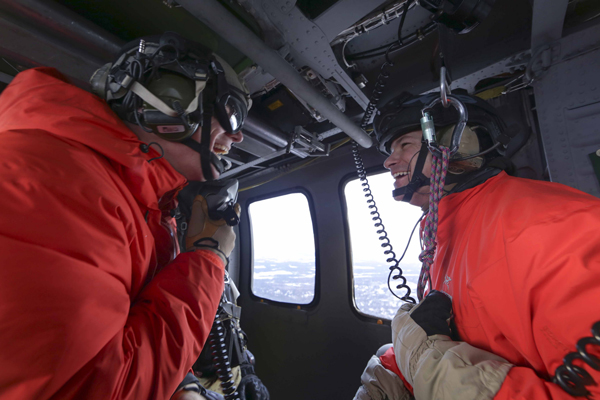
The pilots, engineers and PJs chat through headsets about their landing site, the weather conditions, and who saw their buddies perform.
Sunlight turns the distant Chugach Mountains pink and we fly low enough to the ground to see tufts of grass still poking through the season’s meager snow fall. Soon we fly into a bank of fog near Mount Susitna and the winds pick up dramatically. The helicopter circles around the proposed landing area then after some conversation we move on. The conditions aren’t suitable for what they need to practice – a PJ jumping tandem out of a Hercules C-130 aircraft, carrying another to the ground.
The helicopters soon choose a new location and drop us off with a stretcher and loads of gear. They take off again to practice mid-air refueling.
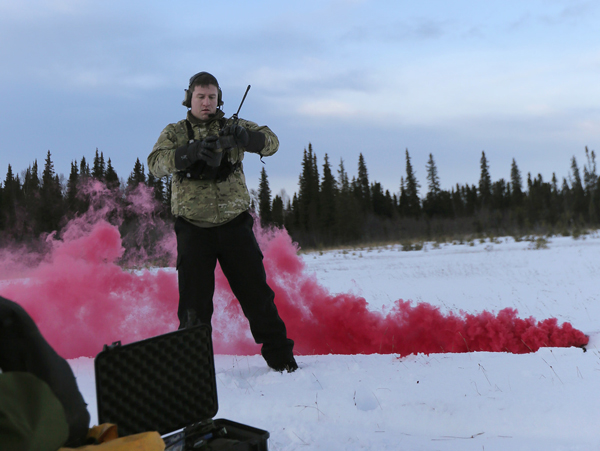
Combat Rescue Officer Aaron Hunter sets up the drop zone.
“I’m just going to mix this in underneath,” he says, testing the wind and laying out rectangles of orange material showing the wind direction.
He radios to the Hercules that’s headed toward the drop zone carrying five more PJs and tells them the altimeter settings for the new location.
“King Bruin….. the setting is 9-4-2,” he said.
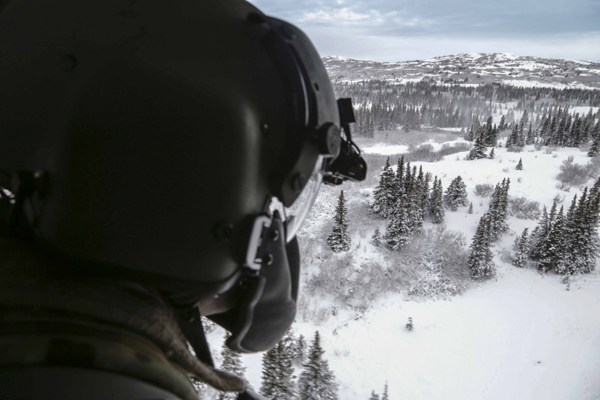
Hunter joined the National Guard straight out of college. He says he had never even heard of it until a month before signing up, but he says it suits him.
“I’ve been in the Guard seven years now and every day has been not the same,” Hunter said. “And that really helps me out because I don’t really have ADD, but I feel like I have ADD a lot.”
He’s worked in Alaska and deployed to Afghanistan and Djibouti. Hunter’s completed hundreds of jumps.
“I don’t even really consider jumping super dangerous anymore,” Hunter said. “There are so many things built into that make it safe. There’s a better chance of me getting hurt on a ladder than I think there is jumping.”
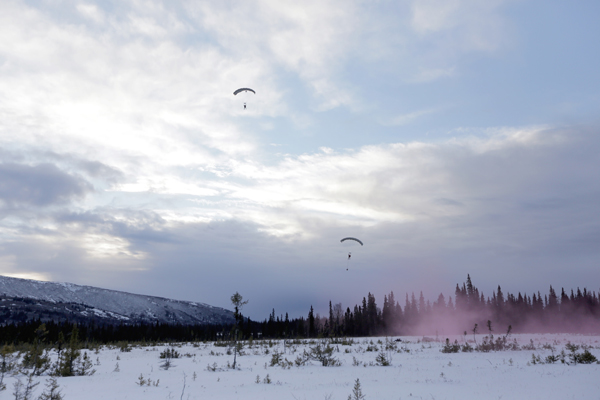
Hunter explains that parachutes have built-in safety mechanisms. The ‘chutes will deploy even if the jumper is unconscious, though they wouldn’t have control over the landing. For Hunter, the joy of being in the guard isn’t the thrill of the jump, it’s helping people.
“So I’ve had a chance to work on several different plane crashes where the people were still alive and you have the ability to administer a little bit of care and then get them out of their bad situation and move them on to higher care,” he said. “No one else in the state would have been able to do anything.”
The National Guard is deployed when the State Troopers can’t reach an area because of equipment, personnel, or weather conditions. The Guard will send out the pilots and PJs. If the area can’t be reached by an aircraft, the PJs drop ATVs and snow machines out of the plane by parachute then use them to access the victims.
During this training mission, the heaviest equipment is a chainsaw brought along in case a PJ lands in a tree. After about a half an hour, the Hercules returns to the drop zone and hurls a streamer out the door. It shows the PJs the wind direction and helps them figure out where to jump.
“They’re gonna fly over where the streamers landed and they’re gonna count how many seconds it takes to get from the streamers to the target, then start the count again after they pass the target then jump out the same distance from streamer to target,” he said.
Hunter starts a bright pink smoke signal to give more pointers.
“It always changes. The situation on the ground is always different than what you think it’s going to be. No matter what it’s always different. And so, winds change. Might as well know the winds are changing,” Hunter said. “And it’s nice to have a physical indicator of that.”
Soon after the four jumpers drift slowly to the ground and land a minute walk away from the blazing orange arrow. Capt. John Romspert led the tandem jump. He says it’s a skill he mostly uses overseas for carrying specialists or translators into action.
“Normally I plan differently because the person I’m jumping has never jumped before,” Romspert said. “Some people have never even seen one of these planes I’m taking them out of. So not only do I have to fly for myself as we sky dive, I have to fly for them and be prepared for them to do everything their not supposed to do.”
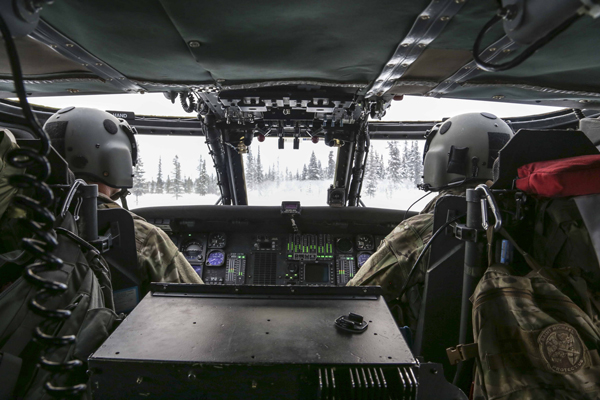
The guardsmen pack up their parachutes and head to the waiting helicopter. This time, Hunter will jump. It’s his first time in about two months. He says he’s slightly anxious.
“I think scared and excited are the same thing sometimes,” Hunter said.
The helicopter takes off again. When the conditions are right, Hunter jumps without hesitation. Others practice hoisting in and out of the airplane on cables, disappearing into the mini blizzard created by the helicopter’s propellers. And soon the training mission is over. Ten of us pack into the back of the aircraft, perched on bags of gear and parachutes, and head back to Anchorage.
Back at JBER, Capt. Aaron Zamora prepares for the mission debriefing. He was Romspert’s passenger, though usually he jumps himself. He was in the Air Force before joining the Alaska Air National Guard.
“For 10 years we practiced with body armor and M4s and night vision goggles. Everything was related to war,” Zamora said. “I was getting a little tired of that, you know? A couple rounds of Iraq, a couple of rounds of Afghanistan. I was kind of over it.”
But Zamora says he wasn’t ready to leave the military, so he moved to Alaska and joined the Guard. Here, he only deploys every other year. His main focus is keeping civilians, Air Force, and aviators safe in the state. He says the role is less stressful but still has its own challenges.
“It’s a little unique here,” Zamora said. “You never know what you’re going to get into, whether it be on a glacier, on a river, or out in the ocean or some sort of rope system you have to set up on the side of cliff to get someone out of their plane.”
Zamora says it’s nice not to have to think about guns or other aircraft, just the environment around you and how to save someone’s life.
Anne Hillman is the healthy communities editor at Alaska Public Media and a host of Hometown, Alaska. Reach her at ahillman@alaskapublic.org. Read more about Anne here.





